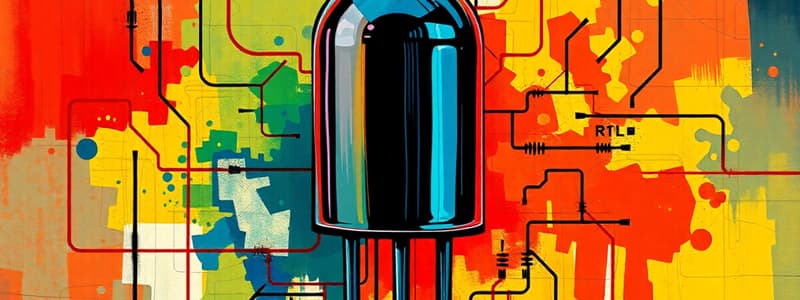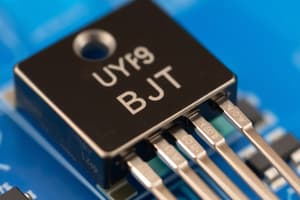Podcast
Questions and Answers
In a swamped amplifier, what effect does the emitter diode have on the circuit's performance?
In a swamped amplifier, what effect does the emitter diode have on the circuit's performance?
- Its effect is negligible and can be ignored. (correct)
- It critically affects the input impedance.
- It becomes vital to the voltage gain.
- It is significant to the overall circuit analysis.
How does adding an emitter feedback resistor impact the distortion in an amplified signal?
How does adding an emitter feedback resistor impact the distortion in an amplified signal?
- It reduces the distortion. (correct)
- It increases the distortion.
- It completely eliminates distortion.
- It has no impact on the signal distortion.
In a swamped amplifier, what is the primary purpose of the emitter resistor?
In a swamped amplifier, what is the primary purpose of the emitter resistor?
- To introduce an AC voltage component.
- To provide a stable DC voltage level. (correct)
- To ground the emitter for AC signals.
- To eliminate any AC voltage at the emitter.
What is the effect on the AC output voltage if the emitter-bypass capacitor in a common-emitter amplifier opens?
What is the effect on the AC output voltage if the emitter-bypass capacitor in a common-emitter amplifier opens?
How is the voltage gain of an amplifier affected if the input impedance of the subsequent stage decreases?
How is the voltage gain of an amplifier affected if the input impedance of the subsequent stage decreases?
What happens to the AC output voltage if the collector resistor is shorted?
What happens to the AC output voltage if the collector resistor is shorted?
If the input coupling capacitor in an amplifier opens, what will be the effect on the AC input voltage?
If the input coupling capacitor in an amplifier opens, what will be the effect on the AC input voltage?
What happens to the AC input voltage at the base if the emitter resistor opens?
What happens to the AC input voltage at the base if the emitter resistor opens?
Which of the following is true about the input impedance of a JFET?
Which of the following is true about the input impedance of a JFET?
In a JFET, what happens when the gate voltage becomes more negative in an n-channel JFET?
In a JFET, what happens when the gate voltage becomes more negative in an n-channel JFET?
Flashcards
Emitter at AC Ground
Emitter at AC Ground
In a common-emitter (CE) stage, the emitter is effectively grounded for AC signals, simplifying the AC analysis.
Swamped Amplifier Feedback
Swamped Amplifier Feedback
A swamped amplifier uses negative feedback to stabilize voltage gain, reduce distortion, and increase input impedance.
JFET Control
JFET Control
JFETs are voltage-controlled devices where the gate voltage modulates the channel width, thus controlling current flow.
JFET Input Impedance
JFET Input Impedance
Signup and view all the flashcards
Self-Bias and V_GS
Self-Bias and V_GS
Signup and view all the flashcards
Transconductance Meaning
Transconductance Meaning
Signup and view all the flashcards
JFET Cutoff
JFET Cutoff
Signup and view all the flashcards
JFET Channel Control
JFET Channel Control
Signup and view all the flashcards
Study Notes
Emitter Configuration
- In a common collector(CC) stage, also known as emitter follower, the emitter is at AC ground.
- In a common emitter(CE) stage, the output voltage is typically dependent on re when an emitter-bypass is incorporated.
- Voltage gain is the output voltage divided by the input voltage.
Input Impedance
- The input impedance of the base decreases as Beta (β) increases.
Voltage Gain and Resistance
- Voltage gain is directly proportional to the AC collector resistance.
Swamped Amplifier Characteristics
- The feedback resistance of a swamped amplifier is large compared to the AC resistance of the emitter diode.
- Compared to a common-emitter (CE) stage, a swamped amplifier features a larger input impedance.
- Increasing the emitter feedback resistance reduces the distortion.
- The emitter of a swamped amplifier has an AC voltage.
- A swamped amplifier employs negative feedback in its design.
- The impact of the emitter diode becomes unimportant in a swamped amplifier.
- The feedback resistor reduces distortion in the amplified signal.
- The feedback resistor stabilizes voltage gain.
AC Collector Resistance
- The AC collector resistance of the first stage includes the input impedance of the second stage.
Effects of Component Failure
- If the emitter-bypass capacitor opens, the AC output voltage decreases.
- If the emitter-bypass capacitor shorts, the DC base voltage increases.
- If the collector resistor shorts, the AC output voltage decreases.
- If the load resistance opens, the AC output voltage increases.
- If any capacitor opens, the AC output voltage decreases.
- If the input-coupling capacitor opens, the AC input voltage decreases.
- If the bypass capacitor opens, the AC input voltage at the base remains the same.
- If the output-coupling capacitor opens, the AC input voltage remains the same.
- If the emitter resistor opens, the AC input voltage at the base remains the same.
- If the collector resistor opens, the AC input voltage at the base is approximately zero.
- If the emitter-bypass capacitor shorts, the AC input voltage at the base is equal to zero.
Multistage Amplifier Effects
- If the input impedance of the second stage decreases, the voltage gain of the first stage decreases.
- If the BE diode of the second stage opens, the voltage gain of the first stage remains the same.
- If the load resistance of the second stage opens, the voltage gain of the first stage increases.
JFET Basics
- A JFET is voltage controlled
- A unipolar transistor uses either free electrons or holes.
- The input impedance of a JFET approaches infinity.
- The gate controls the width of the channel, drain current, and gate voltage.
- The gate-source diode of a JFET should be reverse biased.
- Compared to a bipolar junction transistor (BJT), a JFET has a much higher input resistance.
- Pinch-off voltage magnitude is equal to the gate-source cutoff voltage.
- A JFET acts like a current source when the drain saturation current is less than IDSS.
- RDS equals pinch-off voltage divided by the drain current for zero gate voltage.
- Transconductance curve is nonlinear.
- The transconductance increases when the drain current approaches ID(sat).
- A CS amplifier has a voltage gain of gmrd.
- A source follower has a voltage gain of gmrs/(1+gmrs)
- A source follower has some distortion when the input signal is large.
- A source follower has a voltage gain of less than 1, some distortion and high input resistance when the input signal is large
- The input signal used with a JFET analog switch should be a square wave.
- A cascode amplifier has the advantage of large voltage gain and low input capacitance.
- VHF(Very High Frequency) covers frequencies from 30 to 300 MHz.
- When a JFET is cut off, the depletion layers are touching.
- In an n-channel JFET, the channel between the depletion layers shrinks.
- If a JFET has IDSS = 8 mA and VP = 4 V, then RDS equals 500 Ω.
- The easiest way to bias a JFET in the ohmic region is with self-bias.
- Self-bias produces negative feedback.
- A negative gate-source voltage in a self-biased JFET circuit requires a source resistor.
- Transconductance is measured in mhos or siemens.
Transconductance
- Transconductance indicates how well the input voltage controls the output current.
Studying That Suits You
Use AI to generate personalized quizzes and flashcards to suit your learning preferences.




